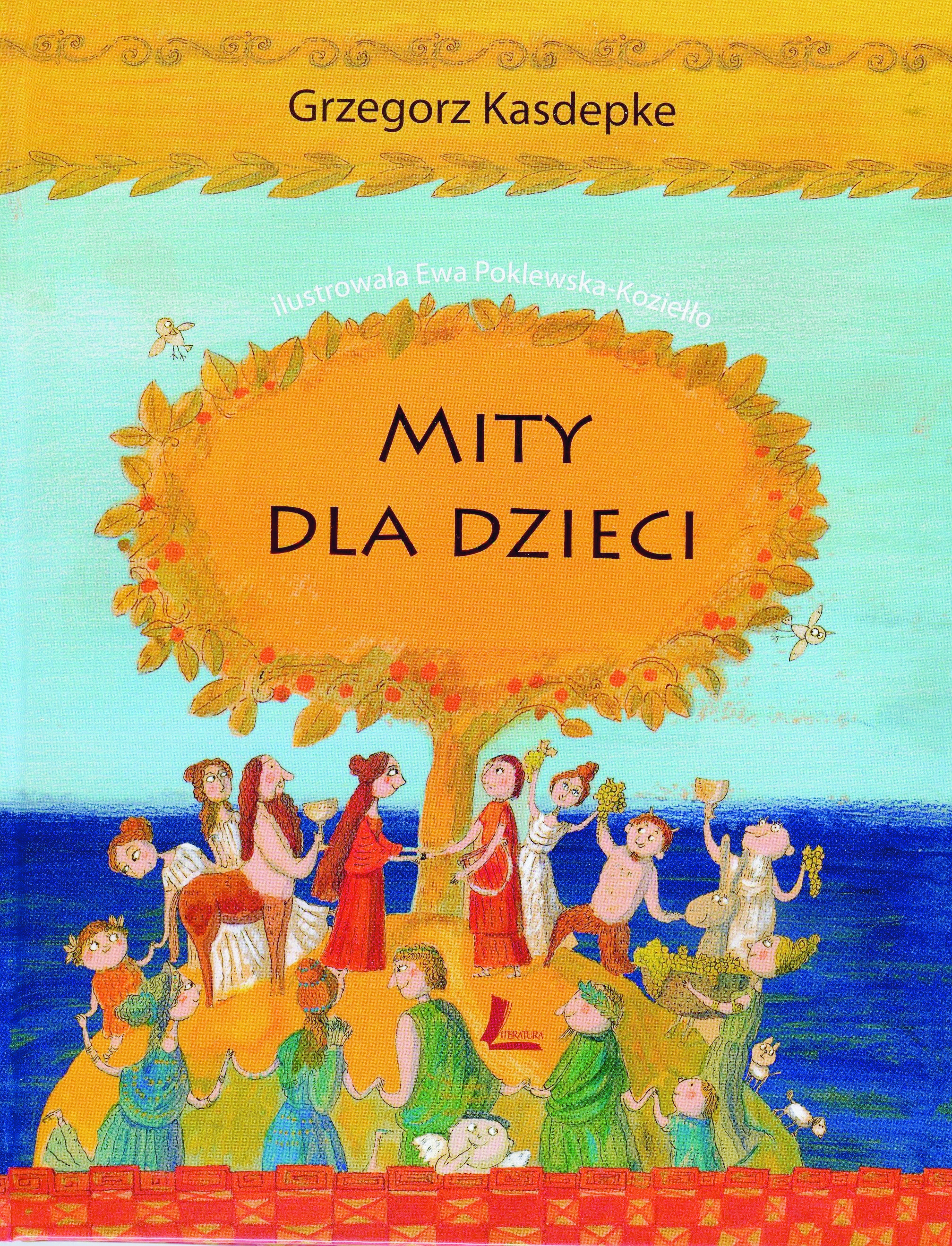Title of the work
Country of the First Edition
Country/countries of popularity
Original Language
First Edition Date
First Edition Details
Grzegorz Kasdepke, ill. Ewa Poklewska-Koziełło, Mity dla dzieci. Łódź: Wydawnictwo Literatura, 2009, 104 pp.
ISBN
Genre
Anthology of myths*
Target Audience
Children
Cover

Cover design and illustrations by Ewa Poklewska– Koziełło. Łódź: Wydawnictwo Literatura, 2011. Courtesy of the publisher.
Author of the Entry:
Summary: Marta Adamska, University of Warsaw, m.adamska91@student.uw.edu.pl
Analysis: Marta Pszczolińska, University of Warsaw, m.pszczolinska@al.uw.edu.pl
Peer-reviewer of the Entry:
Katarzyna Marciniak, University of Warsaw, kamar@al.uw.edu.pl
Elżbieta Olechowska, University of Warsaw, elzbieta.olechowska@gmail.com

Photograph by Katarzyna Marcinkiewicz, courtesy of the Author.
Grzegorz Kasdepke
, b. 1972
(Author)
Born in Białystok, now lives in Warsaw. Attended Faculty of Journalism and Political Science at the University of Warsaw. He made his journalistic debut in the weekly “Polityka.” Author of books for children and teenagers, among them many bestsellers. From 1995 to 2000: Editor-in-Chief of the popular magazine for children “Świerszczyk” [The Little Cricket]. Wrote a number of radio-plays for children, as well as scripts for TV programs and series (Ciuchcia [The Choo-Choo Train], Budzik [The Alarm Clock], Podwieczorek u Mini i Maxa [Afternoon Tea at Mini and Max]). Awarded a number of literary prizes. In his books, Kasdepke attempts to explain to his young readers the complicated adult world demonstrating a sense of humour and an understanding of their needs, like for example in books and audiobooks: Co to znaczy... 101 zabawnych historyjek, które pozwolą zrozumieć znaczenie niektórych powiedzeń [What Does It Mean... 101 Funny Stories Helping to Understand the Meaning of Some Expressions], 2002; Bon czy ton. Savoir–vivre dla dzieci [Bon or Ton. Savoir–vivre for Children], 2004; Horror! Skąd się biorą dzieci [Horror! Where Do the Children Come from?], 2009; Kocha, lubi, szanuje, czyli jeszcze o uczuciach [Loves, Likes, Respects, or Again about Feelings], 2012; W moim brzuchu mieszka jakieś zwierzątko [A Little Animal Lives in My Tummy], 2012. He is also the author of crime stories for children – a series of books about Detektyw Pozytywka [Musical Box Detective], 2005–2011. Received the Kornel Makuszyński Prize for his book Kacperiada. Opowiadania dla łobuzów i nie tylko [Kacperiada. Stories for Rogues and not Only], 2001, inspired by his son Kacper. He considers himself “a 100 per cent fairytale writer.” In a recent TV interview the author confirmed the preparation of a new book for children inspired by ancient mythology – Banda trupków i sandały Hermesa [A Gang of Corpsies and Hermes’ Sandals]. Kasdepke wrote about twenty short stories – adaptations of myths, published in five volumes with varying contents, see descriptions below (with a particular stress on the presentation of the most recent volumes). In 2019 he was awarded the Order of the Smile, an international award given by children since 1968.
Bio prepared by Dorota Rejter, University of Warsaw, dorota@bazylczyk.com, and Maria Karpińska, University of Warsaw, mariakarpinska@student.uw.edu.pl
Translation
Czech: Řecké mýty pro děti, trans. Marta Harasimowicz, Praha: Slovart, 2017.
Russian: Mify dlâ detej, trans. Anna Burmistrova, Minsk: Popurri, 2019.
Slovak: Grécke mýty pre deti, trans. Jozef Marušiak, Bratislava: Buvik, 2015.
Ukrainian: Mìfi dlâ dìtej, trans. Božena Antonâk, L'vìv: Urbìno, 2016, 2017, 2018, 2019.
The translated editions combine Mity dla dzieci with Mity dla dzieci – Zeus & spółka in one collection of 20 myths.
Sequels, Prequels and Spin-offs
The book includes the same stories but in a different sequence that Najpiękniejsze mity dla dzieci, Warszawa: Wydawnictwo Wilga, 2004, 56 pp.
Grzegorz Kasdepke, Mity dla dzieci – Zeus & spółka [Myth for Children – Zeus & Co.], Łódź: Wydawnictwo Literatura, 2011.
Summary
Based on: Katarzyna Marciniak, Elżbieta Olechowska, Joanna Kłos, Michał Kucharski (eds.), Polish Literature for Children & Young Adults Inspired by Classical Antiquity: A Catalogue, Faculty of “Artes Liberales”, Warsaw: University of Warsaw, 2013, 444 pp.
The text of the book is based on Najpiękniejsze mity dla dzieci, Warszawa: Wydawnictwo Wilga, 2004, 56 pp.
The magical and amazing world of ancient gods and heroes shown in an accessible way in simple and amusing language. Each story focuses on a different god or hero.
The ten presented myths include:
- Doktorze, pomocy! [Doctor, help!] about Asclepius,
- Śliczna i mądra – czyli Atena [Lovely and Wise – That Is Athena],
- Figlarz [Trickster] about Eros,
- Zakaz odwracania się [No Turning Around] about Orpheus,
- Proszę Pana [Sir Pan],
- Chimera, chi, chi [Chimaera, Ha, Ha] about Bellerophon,
- Głowa Meduzy [Medusa’s Head] about Perseus,
- Spokojnie, braciszku, spokojnie… [Easy, Bro, Easy…] about Zeus’ and Poseidon’s relations,
- Syzyf nie plotkuj [Don’t Gossip, Sisyphus] and
- Tantal, ty okrutniku! [Tantalus, You Cruel Man!].
Analysis
The author directed his adaptation of ten mythical stories at small children. This is indicated in the adjustments of some issues and familiar language in lively descriptions, including modern forms or diminutives, and witty contemporary dialogues conducted in an everyday speech which brings the text closer to today’s reader. The colorful illustrations are an integral part of the narration and contribute to a warm and casual atmosphere – even monsters look quite nice. Due to this approach and to the use of humour, mythology becomes less serious, pompous or pathetic, and the child can perceive mythical gods, heroes and other characters as very similar to today’s people, even when it is in a distant time and culture. For the same purpose, some contemporary world elements are introduced (Kronos vomits in a toilet, Orpheus would have been on the top of playlists, girls screamed at his concerts, Eurydice dies because no ambulances or mobile phones are available). Some important ancient elements in contemporary life are explained in the adaptation, like the snake-sign on pharmacies (the myth of Asclepius). The author chooses to illustrate some everyday issues with the help of ancient myths: relations with siblings (Zeus and Poseidon), gossip (Sisyphus), cruelty (Tantalus), rage and its consequences (Apollo and Coronis, Zeus and Asclepius, Athena and Arachne), being mocked for being different (Pan), excessive pride and stupidity (Bellerophon). Of course, many positive characteristics of the ancient role models appear, but since virtues are interspersed with vices, the child reader can perceive them as authentic.
Notably, the author does not avoid difficult and sensitive matters present in Greek myths but attempts to adapt them to the potential of a child’s perception, first, using language and vocabulary suitable to the readers’ age. Such matters include: unwanted advances, seduction and love affairs, violence, death, manslaughter, and suicide. The author also does not avoid unhappy endings. For example, in Bellerophon’s story, he states: "If it were a fairy tale, it should have end here. But it is not a fairy tale, but a myth. And a myth does not have to end well" (p. 59). He then narrates the fall of Bellerophon caused by his excessive pride, still preserving an appropriate and accessible language and giving the possibility of an alternative ending. The story of Bellerophon is a good example of how to relate sensitive subjects to children. First, the chapter’s title, Chimera, chi chi is a pun (chi chi is the sound of a nervous chuckle) and an amusing alliteration. Then begins the tale about a boy who accidentally shot his brother while playing with his bow. The consequences for the protagonist are dire; in addition to his loss and feelings of guilt, he must leave his home and country. Such an approach allows the reader to grasp the nature of the situation and generates compassion for the unfortunate character. When the hero visits Proetus, his wife, Antea, called a "mean hag" (wredne babsko) "tried to make a pass at Bellerophon while he was devastated by grief" (p. 52). Thus the vocabulary also contains moral evaluation as words such as “mean” and “hag” paint her as a negative figure even before her attempt at seduction. As Bellerophon is a victim of circumstances in the story and bravely slays Chimaera, the child reader understands that even a mythical hero may accidentally do something bad and, on the other hand, that overconfidence and pride are not virtues and may have grave consequences.
Such moral lessons serve to educate the child, clearly showing that bad behaviour does not pay. We read that gossip and lies, cheating, arguments between brothers, envy or excessive anger are far from admirable. Fortunately, the author does not focus only on negative characteristics.
Endings of adapted myths merit a special mention. The myth of Eros and Psyche concludes even better than Apuleius’ version: Psyche is not forced to pass trials, and Aphrodite forgets her antipathy towards Psyche almost immediately. What is important – as it is a children’s book – even in sad stories, the reader can find something positive and finally be comforted. For example, – the myth of Orpheus and Eurydice seemingly ends within death for both protagonists. The author asks whether it truly is a tragic ending because Orpheus was finally reunited with his beloved wife. A similar interpretation of an otherwise sad ending can be found in the myths of Pan and of Tantalus. While intelligent, witty, likeable and fun, Pan was not considered good looking, and when he proposed to Syrinx, she mocked him and made him realize how ridiculous and ugly he looked. His future did not look bright. And yet, with the followers of Dionysus, he found his perfect place by the god of wine: a happy outcome that could also happen to others, even so-called “freaks” or misfits. Likewise, at the end of Tantalus’ story, children with visible birthmarks can see themselves as connected to the myth of Pelops, and while their archetype, Sisyphus, received a rather hopeless penance, not many people may claim kinship with the heroes of Greek myths.
Further Reading
Hajduk-Gawron, Wioletta, "Sfera linguakultury jako niezbędny element integracji”, Postscriptum Polonistyczne 2 (2019): 247–258 (accessed: May 7, 2021).
Niesporek-Szamburska, Bernadeta, “Dobre maniery, czyli o dydaktyzmie we współczesnej literaturze dziecięcej” in Bernadeta Niesporek-Szamburska and Małgorzata Wójcik-Dudek, eds., Nowe opisanie świata: literatura i sztuka dla dzieci i młodzieży w kręgach oddziaływań, Katowice: Wydawnictwo Uniwersytetu Śląskiego, 2013, 55–69 (accessed: May 7, 2021).
Plieth-Kalinowska, Izabela, „Świadomość językowa uczniów klas trzecich szkoły podstawowej”, Przegląd Pedagogiczny 1 (2015): 111–118 (accessed: May 7, 2021).


